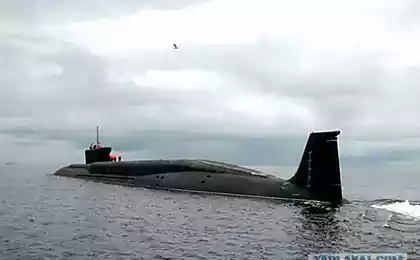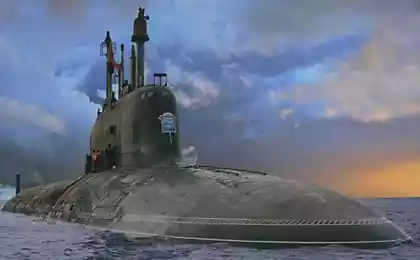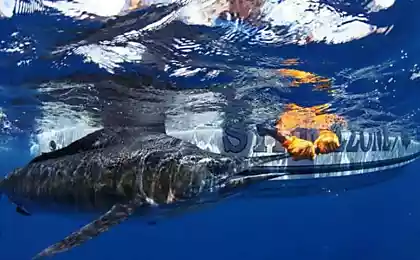1140
"Shark", "pike", "Ohio".
"You're a liar, Nam-Bok, because everyone knows that iron can not swim»
/ Jack London /
18 photos
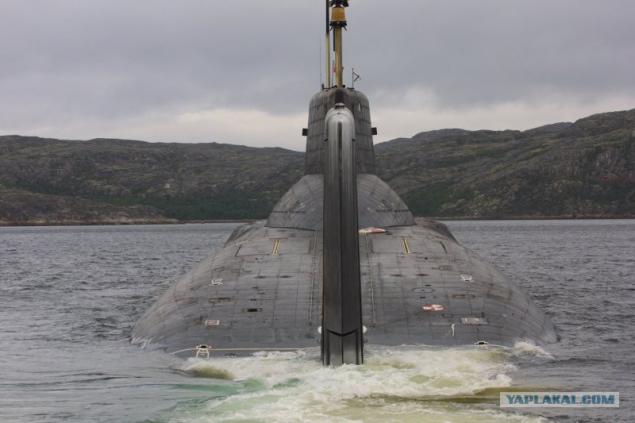
Dear comrades, surely, many of you have visited the naval salons, uncomfortable shaking up the gangplank to the deck of a huge ship. Wandering through the upper deck, looking at rocket launchers containers, spreading branches of radars and other fi system.
Even simple things like the thickness of the anchor chain (each link with pounds of the weight) or radius obmetaniya trunks naval artillery (the size of country Pobol "six hundredth") can cause the unprepared layman sincere shock and bewilderment.
Dimensions of ship mechanisms enormous. Such things do not occur in ordinary life - the existence of these cyclopean things we learn only during a visit to the ship in the Navy the next day (Day of Victory in the days of the St. Petersburg International Maritime Defense Show, etc.).
Indeed, from the perspective of a single person, small or large ships there. Marine engineering impresses with its dimensions - standing on a pier next to the corvette moored man looks like a grain of sand on a background of a huge rock. "Tiny" 2500-ton corvette looks like a cruiser, and the "real" cruiser has all paranormal dimensions and looks like a floating city.
Anchor missile submarine pr. 941 "Shark»

The reason for this paradox is obvious:
The usual four-w / a car (wagon), loaded to the brim with iron ore, has a mass of about 90 tons. It is bulky and heavy piece.
In the case of 11 000-ton missile cruiser "Moskva" we have only 11 000 tons of metal structures, cables and fuel. Equivalent - 120 railway wagons with ore, densely concentrated in a single array.
But the cruiser "Moskva" is not the limit - US aircraft carrier "Nimitz" has a total displacement of more than 100 thousand tons.
Truly great Archimedes, whose immortal law allows it to keep afloat a whopper!
As water keeps this ?! The conning tower battleship "New Jersey»
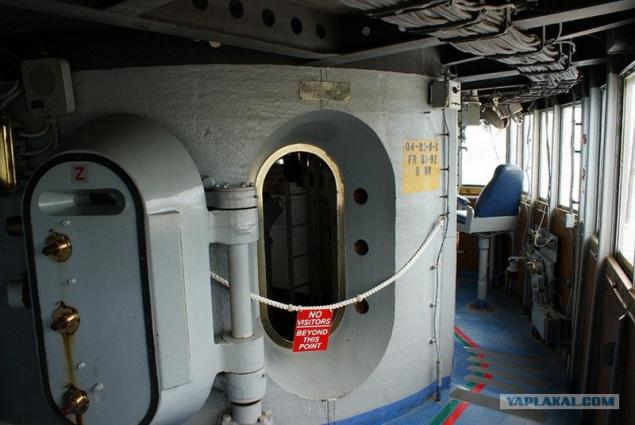
The big difference
Unlike surface ships and vessels, which can be seen in any port, the underwater component has a high proportion of the fleet of stealth. Submarines are difficult to see even during a call to the database - largely due to the special status of a modern submarine fleet.
Nuclear technology, the danger zone, a state secret, the objects of strategic importance; closed city with special passport regime. All of this does not add to the popularity of "steel coffins" and a nice crew. Nuclear boats silently nest in secluded bays Arctic or hidden from prying eyes on the distant coast of Kamchatka. The existence of boats in peacetime can not hear anything. They are not suitable for a naval parade and the notorious "show the flag." The only thing that can do these sleek black ships - to kill.
Baby C-189 on a background of "Mistral»
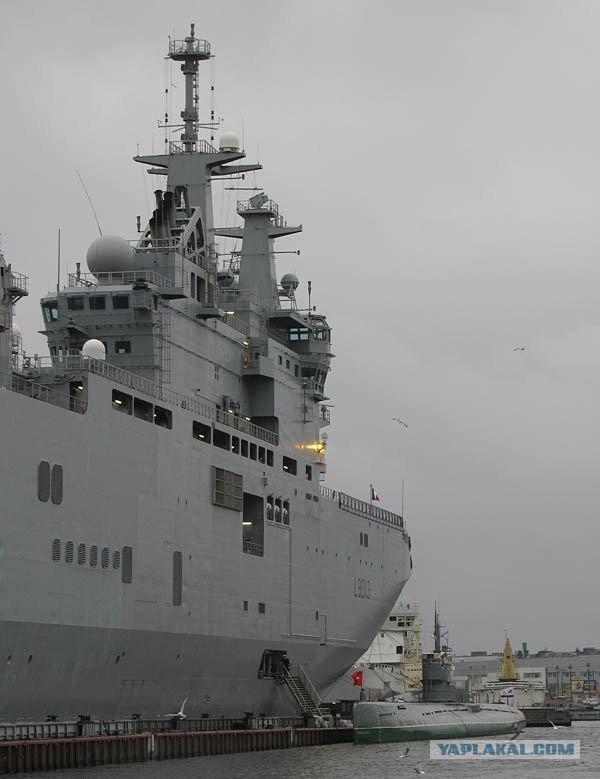
How to look "Baton" or "Pike"? How big is the legendary "shark"? Is it true that she does not fit in the ocean?
Clarify the issue is quite difficult - there are no visual aids on this point. Museums submarine K-21 (Severomorsk), C-189 (St-Petersburg), or C-56 (Vladivostok) are half a century "dizelyuhami" WWII * and do not give any idea of the real size of modern submarines.
* even a relatively "fresh" C-189 built 1950 established on the basis of captured German "Elektrobota»
The reader certainly can gain a lot of interesting from the following illustration:
Comparative size silhouettes of modern submarines in a single scale

The thickest "big fish" - a heavy missile strategic submarine cruisers of Project 941 (code "Shark»).
Here - the American SSBNs "Ohio».
Even lower - underwater "aircraft carrier killer" Project 949A, the so-called "Baton" (which belonged to the project dead "Kursk»).
In the lower left corner of the lurking Russian multipurpose nuclear submarine of project 971 (code "Pike-B»)
And the smallest of the illustrated boat - the modern German diesel-electric submarines "Type 212».
Of course, the greatest interest of the public associated with the "Shark" (aka - "Typhoon" by NATO classification). The boat is really amazing: a hull length of 173 meters, the height from the bottom to the roof cutting is equal to a 9-storey house!
Surface displacement - 23 000 tons; Scuba - 48,000 tons. The figures clearly indicate the huge buoyancy - dive "Sharks" in the ballast tanks of the boat pumped more than 20 thous. Tons of water. As a result, "Shark" received the Navy funny nickname "water carrier".
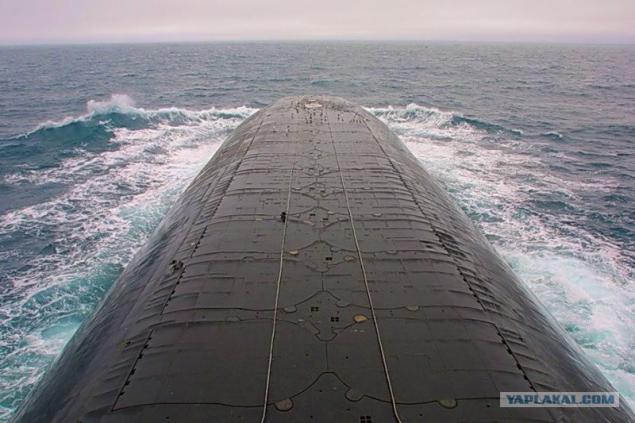
For all the seeming irrationality of the decision (for which such a large submarine buoyancy ??) "water carrier" has its own peculiarities, and even advantages: on the surface sediment monstrous monster is not much more than the "usual" submarines - about 11 meters. This allows you to go to any place home, without the risk of getting run aground, and to use all available infrastructure for servicing submarines. In addition, a huge buoyancy makes the "shark" of a powerful icebreaker. When blowing tank, boat, according to the law of Archimedes, with such force, "rushing" the top, that it does not stop even a 2-meter layer of strong, like a stone, the Arctic ice. Due to this circumstance, "Sharks" could carry on combat duty in the highest latitudes, up to the North Pole.
But even on the surface, "Shark" surprised by its dimensions. How else? - The largest boat in the history of the world!
You can admire the long shark view
Shark & quot; and one of the 677 SSBN family

The boat just is enormous, there is nothing more to add
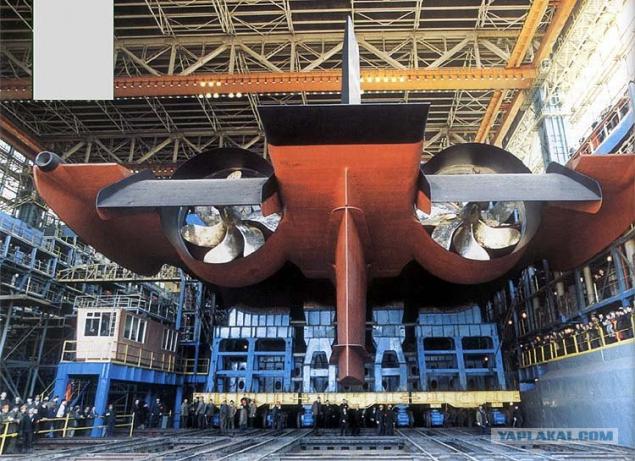
Modern SSBN 955 "Borey" against the backdrop of gigantic fishes
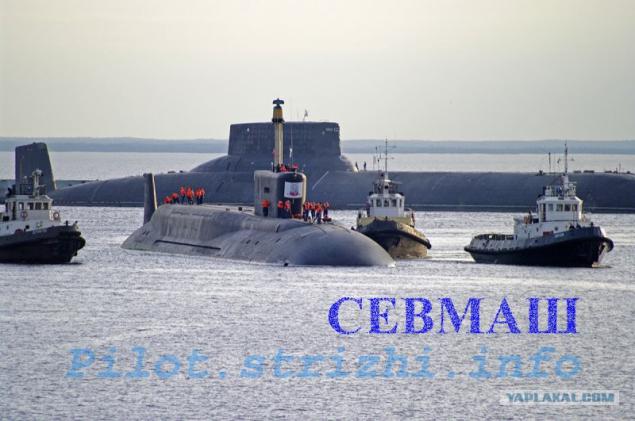
The reason is simple: a lightweight streamlined body hiding two submarine "Shark" is made on a "catamaran" with two Rugged titanium alloys. 19 isolated compartments, dubbed GEM (each of the pressure hull has an independent nuclear steam supply unit OK-650 thermal capacity of 190 MW), as well as two pop-rescue capsule, designed for the entire crew ...
Needless to say - in terms of survivability, security and convenience of placing personnel of this floating "Hilton" was out of competition.
Used 90-ton "kuz'kinu mother»
Just ammunition boat included 20 solid RSM-39
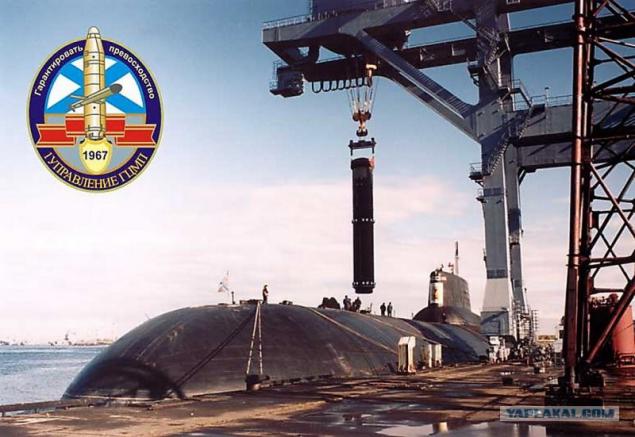
No less surprising is the comparison of the American missile submarine "Ohio" and domestic TRPKSN project "Shark" - suddenly it turns out that they are identical to the dimensions (length 171 m, draft of 11 meters) ... while the displacement is different at times! How so?
No secret there is no - "Ohio" almost twice as inferior to the width of the Soviet monster - 23 to 13 meters. Nevertheless, called "Ohio" small boat would be unfair - 16 700 tonnes of steel structures, and materials inspire respect. Submerged displacement "Ohio" even more - 18 700 tons.
The killer of aircraft carriers
Another underwater monster whose tonnage exceeded the achievements of the "Ohio" (in / Navodnov - 14 700 Underwater - 24,000 tons).
One of the most powerful and sophisticated submarines of the Cold War. 24 supersonic cruise missile with a launch weight of 7 tons; eight torpedo tubes; Nine isolated compartments. Working depth range - more than 500 meters. Submerged speed of over 30 knots.
In order to disperse the "loaf" to such speeds on a boat used two-reactor GEM - day and night, scary black fire burning uranium build two reactors of OK-650. The total energy of 380 MW - enough to provide electricity to the city of 100 000 inhabitants.
"Baton" and Shark
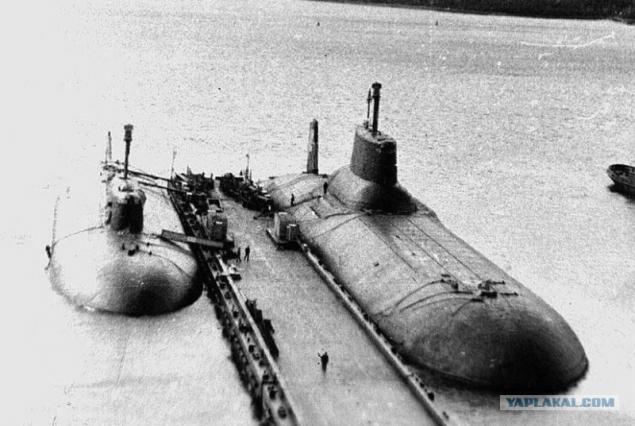
But how justified was the construction of such monsters to solve tactical problems? According to popular legend, the cost of each of the 11 built boats reached half of the value of the aircraft carrier "Admiral Kuznetsov"! The "loaf" was aimed at addressing purely tactical tasks - AUG destruction, convoys violation of enemy communications ...
Two "stick»
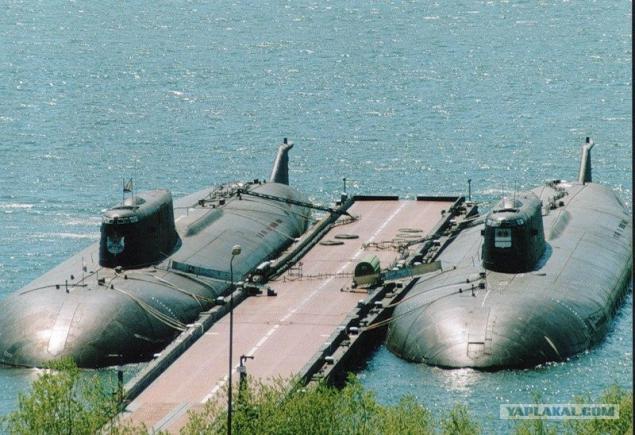
Time has shown that these operations are the most effective multi-purpose submarines, for example -
Pike-B
A series of Soviet nuclear multipurpose submarines of the third generation. The most menacing underwater weapons until the American submarine type "Seawolf».
But you do not think that the Pike-B so small and frail. Size - relative value. Suffice it to say that the baby is not placed on the football field. The boat is huge. Surface displacement - 8100, scuba - 12,800 tons (in the last modifications, it has increased by 1,000 tonnes).
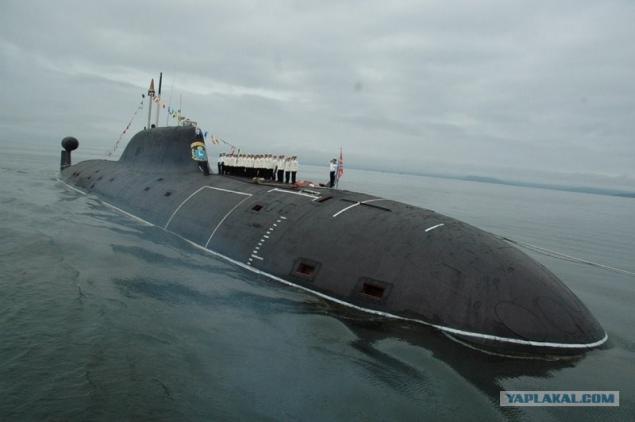
This time the designers, the designers have managed one reactor OK-650, a turbine, a shaft and a propeller. Excellent dynamics remained at the level of 949-th "loaf." There was a modern sonar system and a luxury set of weapons: deep and homing torpedoes, cruise missiles "Pomegranate" (in the future - "Caliber"), rocket-torpedoes "Squall" Plourac'h "Waterfall", thick 65-76 torpedoes, mines while ... , a huge ship operated by a crew of just 73 people.
Why do I say "only"? Just an example: to control a modern American boat-analogue "Pike" - unsurpassed scuba killer of the "Los Angeles" required a crew of 130 people! At the same time, an American, as usual, to limit saturated radio electronics and automation systems, and its size is less than 25% (displacement - 6000/7000 tons).
Incidentally, an interesting question is why the US always boats are smaller? It is all the fault of "the Soviet chip - the biggest chip in the world» ?!
The answer will seem banal - American boats have single-hull structure and as a result, less buoyancy. That is why the "Los Angeles" and "Virginia" so small difference in the values of surface and underwater displacement.
What is the difference between a monohull and doublecase boats? In the first case, the ballast tanks are located inside a single hull. This arrangement takes a part of the internal volume and, in a sense, a negative impact on the vitality of the submarine. And, of course, have a much smaller single-hulled submarine buoyancy. At the same time, it makes a small boat (as it can be small modern submarines) and quieter.
Domestic boat, traditionally built on doublecase scheme. All ballast tanks and deep support equipment (cable, antenna, towed SAS) placed outside the pressure hull. Stiffeners hull also located on the outer side, saving valuable interior volume. On top of all of this is covered by the light "shell».
Advantages: reserve space inside the hull, allowing to realize specific layout solutions. A larger number of systems and weapons on board the boat, unsinkable and increased survivability (additional depreciation at similar explosions, etc.).
Storage of nuclear waste in Sayda Bay (Kola Peninsula)
Seen tens of reactor compartments of submarines. Ugly "ring" - none other than the hull stiffener (pre-light body shot)
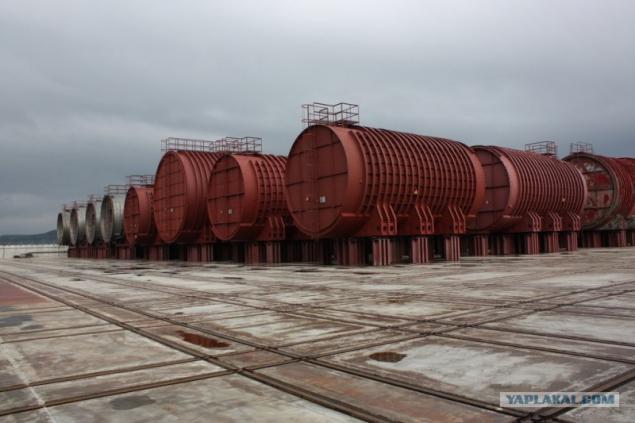
Disadvantages of this scheme is also available and do they not be saved: a large size and area of the wetted surfaces. A direct consequence - Boat louder noise. And if there is a resonance between the durable and lightweight body ...
Should not deceive ourselves heard about the above indicated "reserve space". Inside compartments Russian "pike" still can not drive mopeds and golf - all the reserve was spent on the installation of numerous tight bulkheads. Number of living modules on Russian boats usually ranges from 7 ... 9 units. The maximum is reached at the legendary "shark" - as many as 19 compartments, excluding hermetic process modules in the space of the outer hull.
For comparison - the rugged American "Los Angeles" is divided into watertight bulkheads only three compartments: the central, reactor and turbine (of course, not counting the decks isolated system). Americans have traditionally put on the high quality of manufacturing of hull structures, reliability of equipment and qualified personnel in the composition of the crews of submarines.
Here are the key differences schools submarine on opposite sides of the ocean. A boat still huge.
Hefty big fish. US attack submarines like "Seawolf»
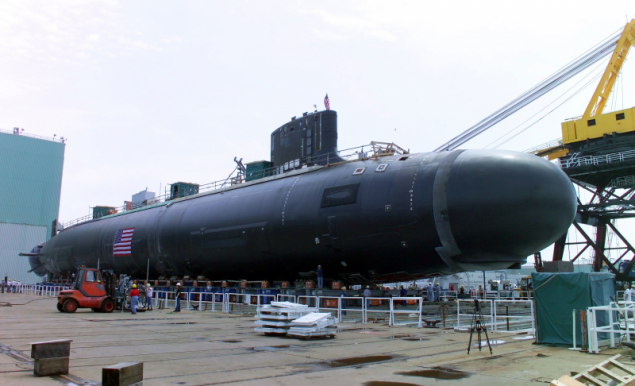
Another comparison to the same scale. It turns out "Shark" is not so large compared with the nuclear aircraft carrier of the "Nimitz" or TAVKR "Admiral Kuznetsov" - the size of aircraft carriers completely paranormal. Winning art of common sense
The little fish left - SSK "Varshavyanka»
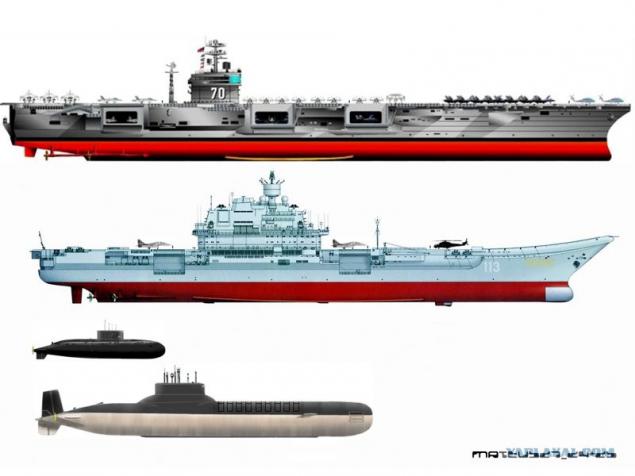
Transportation carved reactor compartments
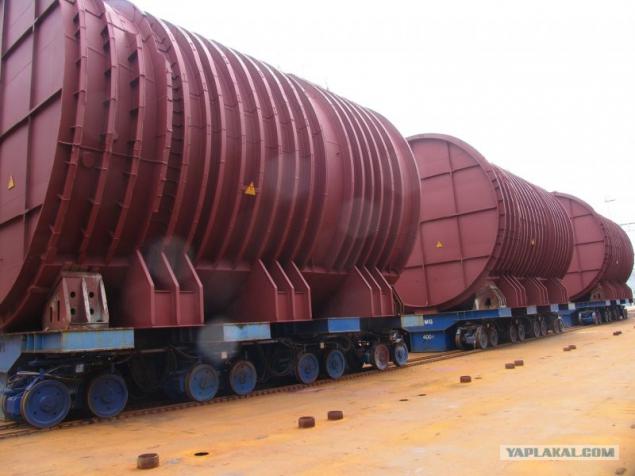
The newest Russian multipurpose nuclear submarine K-329 "Severodvinsk" (adoption of the Navy is scheduled for 2013).
In the background we see two passing recycling "Sharks»
Hence
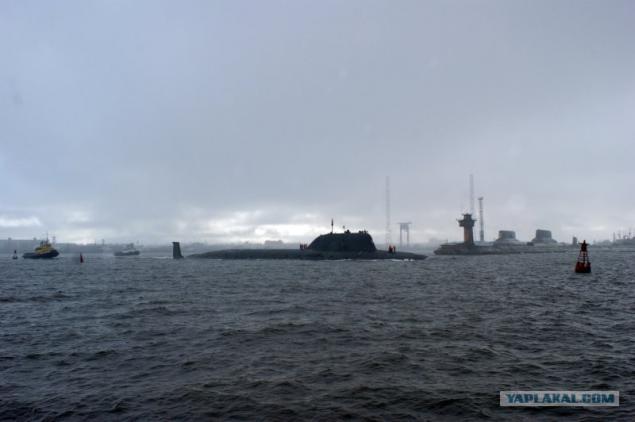
Source:
/ Jack London /
18 photos

Dear comrades, surely, many of you have visited the naval salons, uncomfortable shaking up the gangplank to the deck of a huge ship. Wandering through the upper deck, looking at rocket launchers containers, spreading branches of radars and other fi system.
Even simple things like the thickness of the anchor chain (each link with pounds of the weight) or radius obmetaniya trunks naval artillery (the size of country Pobol "six hundredth") can cause the unprepared layman sincere shock and bewilderment.
Dimensions of ship mechanisms enormous. Such things do not occur in ordinary life - the existence of these cyclopean things we learn only during a visit to the ship in the Navy the next day (Day of Victory in the days of the St. Petersburg International Maritime Defense Show, etc.).
Indeed, from the perspective of a single person, small or large ships there. Marine engineering impresses with its dimensions - standing on a pier next to the corvette moored man looks like a grain of sand on a background of a huge rock. "Tiny" 2500-ton corvette looks like a cruiser, and the "real" cruiser has all paranormal dimensions and looks like a floating city.
Anchor missile submarine pr. 941 "Shark»

The reason for this paradox is obvious:
The usual four-w / a car (wagon), loaded to the brim with iron ore, has a mass of about 90 tons. It is bulky and heavy piece.
In the case of 11 000-ton missile cruiser "Moskva" we have only 11 000 tons of metal structures, cables and fuel. Equivalent - 120 railway wagons with ore, densely concentrated in a single array.
But the cruiser "Moskva" is not the limit - US aircraft carrier "Nimitz" has a total displacement of more than 100 thousand tons.
Truly great Archimedes, whose immortal law allows it to keep afloat a whopper!
As water keeps this ?! The conning tower battleship "New Jersey»

The big difference
Unlike surface ships and vessels, which can be seen in any port, the underwater component has a high proportion of the fleet of stealth. Submarines are difficult to see even during a call to the database - largely due to the special status of a modern submarine fleet.
Nuclear technology, the danger zone, a state secret, the objects of strategic importance; closed city with special passport regime. All of this does not add to the popularity of "steel coffins" and a nice crew. Nuclear boats silently nest in secluded bays Arctic or hidden from prying eyes on the distant coast of Kamchatka. The existence of boats in peacetime can not hear anything. They are not suitable for a naval parade and the notorious "show the flag." The only thing that can do these sleek black ships - to kill.
Baby C-189 on a background of "Mistral»

How to look "Baton" or "Pike"? How big is the legendary "shark"? Is it true that she does not fit in the ocean?
Clarify the issue is quite difficult - there are no visual aids on this point. Museums submarine K-21 (Severomorsk), C-189 (St-Petersburg), or C-56 (Vladivostok) are half a century "dizelyuhami" WWII * and do not give any idea of the real size of modern submarines.
* even a relatively "fresh" C-189 built 1950 established on the basis of captured German "Elektrobota»
The reader certainly can gain a lot of interesting from the following illustration:
Comparative size silhouettes of modern submarines in a single scale

The thickest "big fish" - a heavy missile strategic submarine cruisers of Project 941 (code "Shark»).
Here - the American SSBNs "Ohio».
Even lower - underwater "aircraft carrier killer" Project 949A, the so-called "Baton" (which belonged to the project dead "Kursk»).
In the lower left corner of the lurking Russian multipurpose nuclear submarine of project 971 (code "Pike-B»)
And the smallest of the illustrated boat - the modern German diesel-electric submarines "Type 212».
Of course, the greatest interest of the public associated with the "Shark" (aka - "Typhoon" by NATO classification). The boat is really amazing: a hull length of 173 meters, the height from the bottom to the roof cutting is equal to a 9-storey house!
Surface displacement - 23 000 tons; Scuba - 48,000 tons. The figures clearly indicate the huge buoyancy - dive "Sharks" in the ballast tanks of the boat pumped more than 20 thous. Tons of water. As a result, "Shark" received the Navy funny nickname "water carrier".

For all the seeming irrationality of the decision (for which such a large submarine buoyancy ??) "water carrier" has its own peculiarities, and even advantages: on the surface sediment monstrous monster is not much more than the "usual" submarines - about 11 meters. This allows you to go to any place home, without the risk of getting run aground, and to use all available infrastructure for servicing submarines. In addition, a huge buoyancy makes the "shark" of a powerful icebreaker. When blowing tank, boat, according to the law of Archimedes, with such force, "rushing" the top, that it does not stop even a 2-meter layer of strong, like a stone, the Arctic ice. Due to this circumstance, "Sharks" could carry on combat duty in the highest latitudes, up to the North Pole.
But even on the surface, "Shark" surprised by its dimensions. How else? - The largest boat in the history of the world!
You can admire the long shark view
Shark & quot; and one of the 677 SSBN family

The boat just is enormous, there is nothing more to add

Modern SSBN 955 "Borey" against the backdrop of gigantic fishes

The reason is simple: a lightweight streamlined body hiding two submarine "Shark" is made on a "catamaran" with two Rugged titanium alloys. 19 isolated compartments, dubbed GEM (each of the pressure hull has an independent nuclear steam supply unit OK-650 thermal capacity of 190 MW), as well as two pop-rescue capsule, designed for the entire crew ...
Needless to say - in terms of survivability, security and convenience of placing personnel of this floating "Hilton" was out of competition.
Used 90-ton "kuz'kinu mother»
Just ammunition boat included 20 solid RSM-39

No less surprising is the comparison of the American missile submarine "Ohio" and domestic TRPKSN project "Shark" - suddenly it turns out that they are identical to the dimensions (length 171 m, draft of 11 meters) ... while the displacement is different at times! How so?
No secret there is no - "Ohio" almost twice as inferior to the width of the Soviet monster - 23 to 13 meters. Nevertheless, called "Ohio" small boat would be unfair - 16 700 tonnes of steel structures, and materials inspire respect. Submerged displacement "Ohio" even more - 18 700 tons.
The killer of aircraft carriers
Another underwater monster whose tonnage exceeded the achievements of the "Ohio" (in / Navodnov - 14 700 Underwater - 24,000 tons).
One of the most powerful and sophisticated submarines of the Cold War. 24 supersonic cruise missile with a launch weight of 7 tons; eight torpedo tubes; Nine isolated compartments. Working depth range - more than 500 meters. Submerged speed of over 30 knots.
In order to disperse the "loaf" to such speeds on a boat used two-reactor GEM - day and night, scary black fire burning uranium build two reactors of OK-650. The total energy of 380 MW - enough to provide electricity to the city of 100 000 inhabitants.
"Baton" and Shark

But how justified was the construction of such monsters to solve tactical problems? According to popular legend, the cost of each of the 11 built boats reached half of the value of the aircraft carrier "Admiral Kuznetsov"! The "loaf" was aimed at addressing purely tactical tasks - AUG destruction, convoys violation of enemy communications ...
Two "stick»

Time has shown that these operations are the most effective multi-purpose submarines, for example -
Pike-B
A series of Soviet nuclear multipurpose submarines of the third generation. The most menacing underwater weapons until the American submarine type "Seawolf».
But you do not think that the Pike-B so small and frail. Size - relative value. Suffice it to say that the baby is not placed on the football field. The boat is huge. Surface displacement - 8100, scuba - 12,800 tons (in the last modifications, it has increased by 1,000 tonnes).

This time the designers, the designers have managed one reactor OK-650, a turbine, a shaft and a propeller. Excellent dynamics remained at the level of 949-th "loaf." There was a modern sonar system and a luxury set of weapons: deep and homing torpedoes, cruise missiles "Pomegranate" (in the future - "Caliber"), rocket-torpedoes "Squall" Plourac'h "Waterfall", thick 65-76 torpedoes, mines while ... , a huge ship operated by a crew of just 73 people.
Why do I say "only"? Just an example: to control a modern American boat-analogue "Pike" - unsurpassed scuba killer of the "Los Angeles" required a crew of 130 people! At the same time, an American, as usual, to limit saturated radio electronics and automation systems, and its size is less than 25% (displacement - 6000/7000 tons).
Incidentally, an interesting question is why the US always boats are smaller? It is all the fault of "the Soviet chip - the biggest chip in the world» ?!
The answer will seem banal - American boats have single-hull structure and as a result, less buoyancy. That is why the "Los Angeles" and "Virginia" so small difference in the values of surface and underwater displacement.
What is the difference between a monohull and doublecase boats? In the first case, the ballast tanks are located inside a single hull. This arrangement takes a part of the internal volume and, in a sense, a negative impact on the vitality of the submarine. And, of course, have a much smaller single-hulled submarine buoyancy. At the same time, it makes a small boat (as it can be small modern submarines) and quieter.
Domestic boat, traditionally built on doublecase scheme. All ballast tanks and deep support equipment (cable, antenna, towed SAS) placed outside the pressure hull. Stiffeners hull also located on the outer side, saving valuable interior volume. On top of all of this is covered by the light "shell».
Advantages: reserve space inside the hull, allowing to realize specific layout solutions. A larger number of systems and weapons on board the boat, unsinkable and increased survivability (additional depreciation at similar explosions, etc.).
Storage of nuclear waste in Sayda Bay (Kola Peninsula)
Seen tens of reactor compartments of submarines. Ugly "ring" - none other than the hull stiffener (pre-light body shot)

Disadvantages of this scheme is also available and do they not be saved: a large size and area of the wetted surfaces. A direct consequence - Boat louder noise. And if there is a resonance between the durable and lightweight body ...
Should not deceive ourselves heard about the above indicated "reserve space". Inside compartments Russian "pike" still can not drive mopeds and golf - all the reserve was spent on the installation of numerous tight bulkheads. Number of living modules on Russian boats usually ranges from 7 ... 9 units. The maximum is reached at the legendary "shark" - as many as 19 compartments, excluding hermetic process modules in the space of the outer hull.
For comparison - the rugged American "Los Angeles" is divided into watertight bulkheads only three compartments: the central, reactor and turbine (of course, not counting the decks isolated system). Americans have traditionally put on the high quality of manufacturing of hull structures, reliability of equipment and qualified personnel in the composition of the crews of submarines.
Here are the key differences schools submarine on opposite sides of the ocean. A boat still huge.
Hefty big fish. US attack submarines like "Seawolf»

Another comparison to the same scale. It turns out "Shark" is not so large compared with the nuclear aircraft carrier of the "Nimitz" or TAVKR "Admiral Kuznetsov" - the size of aircraft carriers completely paranormal. Winning art of common sense
The little fish left - SSK "Varshavyanka»

Transportation carved reactor compartments

The newest Russian multipurpose nuclear submarine K-329 "Severodvinsk" (adoption of the Navy is scheduled for 2013).
In the background we see two passing recycling "Sharks»
Hence

Source:
